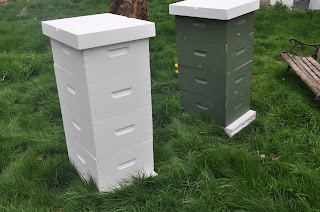Dave made a comment on my post about assembling bee hives:
"Bruce, hives painted a dark green actually do better in the snohomish climate, during the winter on sunny days the green absorbs more heat and they will actually get active even on the coldest of days, while the white hives will remain dormant."
"forest green"
The two hives are set up identically. Same bottom, contents, top. I chose to use deep hive bodies because they present more square inches of surface area. In the winter most hives are two boxes in this area. With four deep hive boxes any heating experienced should be amplified.
Chose a probe thermometer so that I don't have to open the hive to check temp.
Both thermometers display the same temperature; both accurately read boiling water at 212, and freezing water at 32, so I'm pretty sure that they're accurate in the range I want.
The probe is hanging between frames, not touching anything, and placed in the top of the hive, where the warmest air would be.
After four hours on a semi-cloudy afternoon they're reading the same temperature. Darker paint makes no difference today.
If bees were in the hives it would be impossible to isolate the heating benefit of darker colors -- the bees maintain the hive at a temperature that is comfortable for them, by consuming honey and exercising to generate heat, or collecting water and evaporating it in the hive to cool. The original "swamp cooler".
I'll leave this up for a week or two and check the temperature periodically. It really doesn't matter what the temperature is -- what I want to know is if there is any difference in temperature between these two hives.
When the hives are full of bees and honey, they can weigh hundreds of pounds. that's a huge thermal mass, and I think that all of that mass would make the hives slower to warm up. With the hive bodies empty except for sheets of wax in the frames, the air inside should benefit from any heating faster than it would if they were full. What I'm saying here is that if darker colors make any difference, we'll see them.
4 days ago














6 comments:
I will be interested to see how the test works out, either way you will find that on sunny days in the winter the green hive will become active while the white hive will not.
Similar but not quite the same is hives that get the sun earlier in the day will become more active quicker than hives that get the sun later in the day.
A beekeeper wrote an article about winter clusters, he used a thermal camera,same as the fire department uses and took photos during the winter, they showed that the interior of the hive stayed at ambient and only the cluster was warmed, they do not expend energy to heat the empty parts of the hive
No reading today; the wind blew off one of the hive covers (the white hive, not that it matters). I'll do readings the rest of this week. and put a brick on the hive top.
I painted all my hives a dark color for this reason.
No temperature difference today; cloudy and windy
Partly sunny today. No temperature difference.
partly sunny today; no temperature difference.
Post a Comment